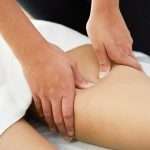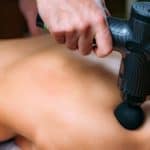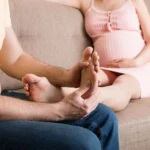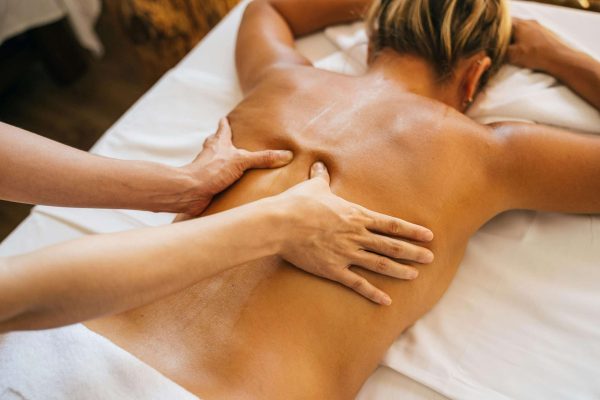A pulled muscle can stop you in your tracks—whether it happens at the gym, on the field, or just moving the wrong way. The initial pain can be sharp and sudden, leaving you unsure of what to do next. Once the swelling settles, many people wonder: can massage help a pulled muscle, or will it make things worse?
The truth is, massage can be a powerful recovery tool—but only when used correctly and at the right time. Done too early, and it can aggravate the injury. But with the right timing and gentle technique, massage can help ease tension, improve circulation, and support healing as part of your overall recovery strategy. In this guide, we’ll walk you through exactly how to massage a pulled muscle, when to avoid it, and how to support faster healing alongside rest, stretching, and other at-home care.
Table of Contents
🤔 What Is a Pulled Muscle?
A pulled muscle, also known as a muscle strain, happens when muscle fibers overstretch or tear. It usually results from sudden movement, overexertion, or not warming up properly. Muscle strains can affect anyone—from elite athletes to people who simply lift something the wrong way.
They often occur during activities like sprinting, lifting weights, abrupt twisting motions, or even carrying groceries awkwardly. Commonly affected areas include the hamstrings, lower back, shoulders, neck, and calves—essentially, any muscle that bears load or stretches under pressure.
Recognizing the signs of a strain early can help you avoid worsening the injury and begin proper care immediately.
Common symptoms:
- Sudden sharp pain
- Muscle tightness or spasms
- Swelling or bruising
- Pain when moving or using the muscle
- Limited range of motion
❓Should You Massage a Pulled Muscle?
This is one of the most important questions after an injury:
👉 Should you massage a pulled muscle?
The answer is: Yes—but timing matters.
✅ When massage helps:
- 48–72 hours after the injury (once swelling and inflammation decrease)
- During the healing or subacute phase
- To relieve tension in surrounding muscles
- To promote muscle strain recovery
❌ When to avoid massage:
- In the first 24–48 hours post-injury
- If swelling, bruising, or sharp pain is still present
- If the muscle shows signs of a tear (e.g., major bruising, lump, or deformity)
🔎 According to the Cleveland Clinic, muscle strains should initially be treated with R.I.C.E. before beginning manual therapy like massage.
🌿 Benefits of Massage for Muscle Strain Recovery
A properly timed and applied massage offers more than just comfort—it encourages real physiological healing. Improved blood flow helps deliver oxygen and nutrients to the strained area, while lymphatic stimulation supports the removal of waste products like lactic acid and cellular debris.
Massage also triggers the release of endorphins, the body’s natural painkillers, helping to reduce discomfort and improve mood. It can ease compensatory tension that builds in surrounding muscles, which often tighten to protect the injured area.
Regular massage during recovery may even prevent the formation of adhesions (knots) or scar tissue, helping you regain mobility faster and reduce the risk of re-injury.

✋ How to Massage a Pulled Muscle: Step-by-Step Guide
If you’re past the initial injury phase and ready for some hands-on help, here’s how to massage a pulled muscle safely:
🌡 Step 1: Wait Until the Time Is Right
Give your body 48–72 hours before attempting massage. Let the inflammation go down first. Trying too soon can aggravate the area and delay healing.
🧴 Step 2: Use a Healing Massage Oil
Apply a small amount of oil to the area to reduce friction. Arnica is particularly helpful for inflammation, while peppermint may provide a soothing, cooling effect. Choose an oil that won’t irritate the skin.
💆 Step 3: Start With Gentle Effleurage
Use long, light gliding strokes to warm the area and stimulate circulation. Spend 3–5 minutes slowly working around the strained muscle—not directly over the tender spot. You should feel warmth and softening of the tissue, not pain.
🔄 Step 4: Use Light Pressure Only
Avoid pressing deep into the muscle. Instead, use gentle kneading with your thumbs or palms to coax the surrounding muscles into relaxing. Pressure should never exceed a “comfortably sore” feeling. If the person flinches or tenses up, it’s too much.
🌀 Step 5: Try Myofascial Release
To relieve deeper tension, apply light pressure with your fingers or a soft tool (like a ball) and hold for 30–60 seconds. You may feel the tissue slowly soften or release. If it doesn’t, ease off and try again the next day.
❄️ Step 6: End With a Cold Compress
Finish with a cold pack for 10–15 minutes, especially if the area feels irritated or warm. This reduces any lingering inflammation that might be triggered by massage.

🔁 How Often Should You Massage a Pulled Muscle?
Once you begin massaging the muscle during the recovery phase (typically after 48–72 hours), the frequency and duration matter.
✅ Start with short, gentle sessions, 5–10 minutes long
✅ Massage once daily, or every other day depending on sensitivity
✅ Always monitor for signs of irritation — if pain or swelling increases, reduce frequency
As the muscle heals, you can gradually increase session length and include more surrounding muscles. Avoid over-massaging, which can cause further irritation or inflammation, especially if done with high pressure or poor technique.
Consistency, not intensity, is the key to progress.
🔧 Massage Techniques That Work for Pulled Muscles
The following techniques are gentle and recovery-friendly:
- Effleurage – long, sweeping strokes that relax muscles and improve circulation
- Petrissage – light kneading to ease tension without deep pressure
- Myofascial release – sustained gentle pressure on connective tissue
- Cross-fiber friction – for more advanced recovery stages to realign muscle fibers
💡 Need help learning effleurage or deep tissue release techniques? Check out our guides:
👉 What Is Effleurage Massage?
👉 Deep Tissue Release Massage Guide
🔍 Massage for Muscle Tear vs. Strain – What’s the Difference?
Many people confuse a pulled muscle (strain) with a muscle tear, but they’re not always the same.
- A strain means the muscle fibers are overstretched or slightly torn — usually a mild to moderate injury.
- A muscle tear refers to a more severe rupture, which may be partial or complete, often requiring medical attention.
Massage for muscle tear:
- 🟡 Mild to moderate tear: Once cleared by a physio, gentle massage of surrounding areas may help reduce stiffness and promote circulation
- 🔴 Severe or complete tear: Avoid massage. These injuries often need rest, bracing, or even surgery
If you’re not sure whether you’re dealing with a strain or tear, avoid self-massage and consult a healthcare provider. Attempting deep massage on a severe tear can worsen the injury or delay healing.
🧑⚕️ When to See a Professional
If your pulled muscle isn’t improving after a few days of rest and gentle care, it may be time to consult a physiotherapist, chiropractor, or licensed massage therapist.
Signs you need professional support:
- Pain is worsening instead of improving
- Swelling or bruising continues beyond 3–5 days
- You’re unable to bear weight or use the affected muscle
- There’s a noticeable lump or gap in the muscle
A specialist can perform manual assessments, like checking your range of motion, flexibility, and muscle integrity through palpation (feeling the muscle). They may use ultrasound or refer you for imaging (like an MRI) if they suspect a muscle tear rather than a strain.
They’ll also design a tailored recovery plan, which may include sports injury massage, stretching routines, and strengthening exercises. For serious or recurring injuries, having this expert input can significantly reduce your recovery time.

🚫 When Massage Isn’t Enough
Massage can do wonders for muscle strain recovery, but it’s not a cure-all. If your pulled muscle isn’t responding to care after several days—or if massage seems to worsen the pain—it might be time to consider further assessment.
Persistent pain, significant swelling, or a lack of improvement could indicate a more serious issue like a partial or complete muscle tear, or an injury to nearby tendons or ligaments. In these cases, continuing to massage the area may delay healing or mask underlying problems.
You may need diagnostic imaging such as:
- Ultrasound to assess muscle fibers
- MRI to detect soft tissue tears
- X-ray to rule out associated bone involvement (in cases of trauma)
If you’ve been asking yourself, “should you massage a pulled muscle” and you’re still in pain after 5–7 days, it’s smart to consult a physio or sports medicine specialist. They can help you get an accurate diagnosis and a personalized treatment plan.
🧪 Example: Recovering from a Hamstring Strain
Let’s say you pulled your hamstring during a jog or sprint. You felt a sudden sharp pain and had to stop mid-stride. Here’s how your recovery timeline might look:
Day 1–2:
- Use R.I.C.E. method: rest, ice, compression, elevation
- Avoid stretching or massage
- Take anti-inflammatory medication if needed (under guidance)
Day 3–4:
- Swelling has reduced
- You start gentle effleurage massage around the injury, using arnica oil
- Focus only on surrounding muscles — no direct pressure on the strain
- Apply a cold compress after massage if needed
Day 5–6:
- Introduce light myofascial release
- Begin gentle stretching (e.g., hamstring wall stretch)
- Use heat therapy before massage for better tissue pliability
- Add self-massage tools like a soft massage ball
Day 7 onward:
- Gradually increase massage pressure if pain-free
- Start mobility work and controlled strengthening
- Resume light activity, walking, or low-impact exercises
- Continue massage every 1–2 days as needed
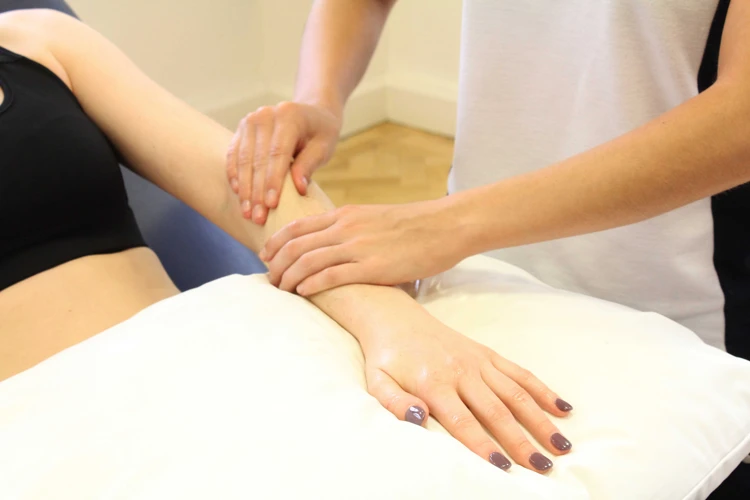
❓Frequently Asked Questions
❓Frequently Asked Questions
Do you massage a pulled muscle?
Yes—but only after the initial 48–72 hours. Early massage can worsen swelling. Once pain and inflammation go down, massage can help increase circulation and promote healing.
Can a massage help a pulled muscle?
Massage supports healing by reducing stiffness, improving blood flow, and calming tight areas around the injury. It can be a valuable part of muscle strain recovery when done gently.
How long does a pulled muscle take to heal?
The healing time varies depending on the severity of the strain:
- Grade I (mild): 3–7 days
- Grade II (moderate): 2–4 weeks
- Grade III (severe): 6–8+ weeks (may involve partial tear)
Massage can be introduced safely around day 3–4 for minor strains, but wait longer for more serious injuries—and always consult a physio if unsure.
How to speed up muscle strain recovery?
To recover more quickly:
- ✅ Follow the R.I.C.E. method for the first 48 hours
- ✅ Massage gently after swelling subsides
- ✅ Stretch lightly to prevent stiffness
- ✅ Use a foam roller or massage gun to release tension
- ✅ Take anti-inflammatory supplements like turmeric or magnesium to ease soreness
- ✅ Eat protein-rich meals and stay hydrated
If mobility is limited, consider contrast therapy (alternating heat and cold), which some athletes use to reduce muscle recovery time.
Can massage make a pulled muscle worse?
Yes—if done too early or with too much pressure. Always listen to your body. If the massage causes pain or swelling, stop immediately.
Is massage good for a muscle tear?
Massage may help with minor muscle tears in the later recovery stages. For severe tears, consult a professional before starting massage.
🧘 Final Thoughts: Heal Gently, Heal Well
A pulled muscle doesn’t have to derail your routine for long—but recovery takes patience. Using massage as part of a complete care plan, along with rest, hydration, proper nutrition, stretching, and strength rebuilding, will give your body the support it needs to bounce back.
Done at the right time, massage a pulled muscle gently and listen to your body’s signals. With consistency and care, you can reduce pain, improve movement, and prevent future strains from sidelining you again.
🧘 Tight back muscles from overcompensating?
This article walks you through safe techniques for back relief:
👉 How to Massage Back: Techniques for Tension Relief
📚 References
- Healthline: Pulled Muscle Treatment
- Cleveland Clinic: Muscle Strains
- Can Massage Therapy Benefit Athletic Recovery?
- Mayo Clinic: Muscle Strain First Aid
⚠️ Disclaimer:
This article is for informational purposes only and does not constitute medical advice. Always consult with a licensed healthcare provider or certified massage therapist before beginning any new treatment, especially if you have pre-existing health conditions or concerns.


